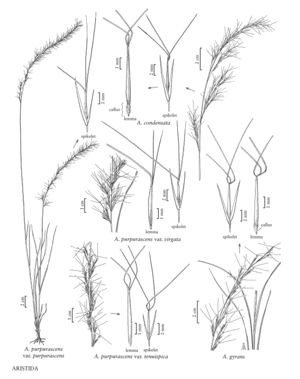Aristida condensata
Plants perennial; bases knotty, bleached, not rhizomatous. Culms 70-150 cm tall, 3-6 mm thick at the base, erect, rarely branched. Leaves mostly cauline; sheaths usually longer than the internodes, remaining intact at maturity, glabrous or appressed pilose; collars glabrous or pilose at the sides; ligules less than 0.5 mm; blades (10) 15-30 cm long, 1.5-3 mm wide, flat at the base, involute toward the apex, straight to somewhat lax at maturity, glabrous abaxially, yellowish-green when fresh, drying stramineous or darker. Inflorescences paniculate, (15) 20-55 cm long, 2-4 cm wide; nodes glabrous or with short, straight hairs; primary branches (4) 5-20 cm, appressed to narrowly ascending, without axillary pulvini, naked below, with 5-15 overlapping spikelets distally. Glumes 6-10 (12) mm, 1-veined, 1-keeled, awns less than 4 mm, brownish; lower glumes from 3/4 as long as to 1 mm longer than the upper glumes; calluses 1-2 mm; lemmas 5-8 mm, often reddish-mottled, apices not strongly twisted, junction with the awns not evident; awns about equally thick, divergent, spirally contorted at the base but usually not with distinct coils, not disarticulating at maturity; central awns 10-15 mm; lateral awns 8-13 mm; anthers 3, about 2 mm. Caryopses 4-5 mm, chestnut-colored. 2n = unknown.
Distribution
Ga., N.C., Ala., S.C., Miss., Fla.
Discussion
Aristida condensata grows on sandy hills, and in pine and oak barrens in the southeastern United States.
Selected References
None.
Lower Taxa
"decumbent" is not a number.
